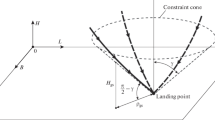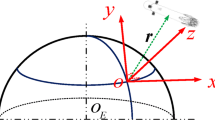Abstract
The problem of precise and soft lunar landing in a pre-specified target location is solved using a numerical scheme based on indirect approach. In indirect approach, the problem is transformed into a two-point boundary value problem using Pontryagin’s principle and solved. The challenge in the indirect approach lies in finding suitable initial co-states with no prior knowledge available about them. In the proposed numerical scheme, the differential transformation (DT) technique is employed to determine the unknown initial co-states using the information on the target site and the flight time. The flight time, the only unknown, is handled by differential evolution, an optimization technique. The novel computational scheme combines differential transformation and differential evolution techniques and uses differential transformation in multi-steps, to ensure the precise landing at the target site. The guidelines that help fixing the bounds for the flight time are provided. The proposed scheme is uniformly valid for various performance measures such as minimum fuel, minimum control and minimum time. Also, it is capable of introducing coasting during descent while maximizing the landing mass.




Similar content being viewed by others
References
F. V. Bennett, Apollo Lunar descent and ascent trajectories. NASA TM-X-58040, March (1970)
A. W. Wilhite, J. Wagner. Lunar module descent mission design. In: AIAA/AAS Astrodynamics Specialist Conference and Exhibit. AIAA 2008–6939, August 18–21, (2008), Honolulu,Hawaii, USA
H. Chu, L. Maa, K. Wang, Z. Shao, Z. Song, Trajectory optimization for lunar soft landing with complex constraints. Adv. Space Res. 60(2017), 2060–2076 (2017)
H. Leeghim, D.-H. Cho, D. Kim, An optimal trajectory design for the lunar vertical landing. Proc IMechE Part G: Journal of Aerospace Engineering 230(11), 2077–2208 (2016)
S. Mathavaraj, R. Pandiyan, R. Padhi, Constrained optimal multi-phase lunar landing trajectory with minimum fuel consumption. Adv Space Res 60(2017), 2477–2490 (2017)
B.G. Park, M.J. Tahk, Three dimensional trajectory optimization of soft lunar landings from the parking orbit with considerations of the landing site. Int J Cont Automat Syst 9(6), 1164–1172 (2011)
R.V. Ramanan, Madanlal. , Analysis of optimal strategies for soft landing on the moon from lunar parking orbits. J Earth Syst Sci (2005). https://doi.org/10.1007/BF02715967
N. Remesh, R.V. Ramanan, V.R. Lalithambika, Fuel optimum lunar soft landing trajectory design using different solution schemes. Int Rev Aerospace Eng (IREASE) (2016). https://doi.org/10.15866/irease.v9i5.10119
F. Fahroo, I.M Ross, Costate estimation by Legdendre Pseudo spectral method. J Guid Control Dyn, 24, No.2 March-April (2001), pp.270-277
D. A. Benson, G. T. Huntington, T. P. Thorvaldsen, A. V Rao, Direct trajectory optimization and co-state estimation via an orthogonal Collocation, Journal of Guidance, Control, and Dynamics, 29, No. 6, November–December (2006), pp.1435–1440.
E. Taheri, N. I.Li, I. Kolmanovsky Co-states initialization of minimum-time low thrust trajectories using shape-based methods. In: 2016 American Control Conference, July 6-8, (2016), Boston, MA, USA
G. E. Pukhov. G.E, Expansion formulas for differential transforms. Cybernetics and System analysis, (1981), 17, Issue 4, pp.460–464.
I. Hwang, J. Li, D. Du (2008) A numerical algorithm for optimal control of a class of hybrid systems: differential transformation based approach. Int J Cont, Vol 81, No.2, (2008), pp. 277–293
H. Rosemary, H. Inseok, C. Martin, A new nonlinear model predictive control algorithm using Differential Transformation with application to interplanetary low-thrust trajectory tracking. (2009) American Control Conference, June 10–12 2009.
A.D. Olds, C. A. Kluever, M. Cupples, Interplanetary mission design using differential evolution. J Spacecraft Roc, Vol.44, No.5, (2007), pp.1060-1070
Author information
Authors and Affiliations
Corresponding author
Ethics declarations
Conflict of interest
The authors declare that there is no conflict of interest.
Additional information
Publisher's Note
Springer Nature remains neutral with regard to jurisdictional claims in published maps and institutional affiliations.
Rights and permissions
About this article
Cite this article
Remesh, N., Ramanan, R.V. & Lalithambika, V.R. A Novel Indirect Scheme for Optimal Lunar Soft Landing at a Target Site. J. Inst. Eng. India Ser. C 102, 1379–1393 (2021). https://doi.org/10.1007/s40032-021-00748-x
Received:
Accepted:
Published:
Issue Date:
DOI: https://doi.org/10.1007/s40032-021-00748-x




